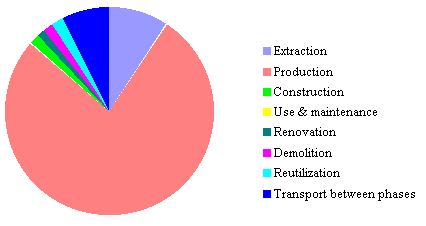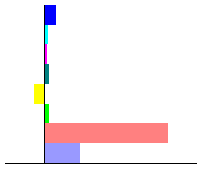Renere teknologi i tegl- og mørtelbranchen
Life cycle assesment - basis for cleaner technology
Future environmental improvement in the Danish Brick- and Mortar Trade is based on a life cycle assessment of clay brick, tile and mortar materials. Environmental improvement demands practical solutions for cleaner technology. This is now created in the shape of realistic proposals for cleaner technology in production of brick and mortar - and by the evaluation of different alternative materials potential use in brick and mortar products.
The results of the project have exposed that especially the production phase provides considerable contribution to the total environmental impact - in shape of high energy consumption and emissions to the air. In the later life cycle phases, it is especially waste and occupational health that provides the environmental impact.
Life cycle assessment gives a general view
Background and purpose
The project is carried through in the aim to enhance use of cleaner technology for brick, tile and mortar products. Environmental conditions have been analysed for all phases in the life cycle of materials in order to propose cleaner technology solutions in the fields with high environmental impacts.
The solutions describe realistic ways to solve environmental problems and are e.g. useful in the following relations:
- As BAT solutions (Best Available Technology) in the trade. BAT is a part of the EEC IPPC directive, which will be a part of the Danish environmental legislation.
- List of goals for environmental management.
The project is a part of a larger coordinated effort to enhance use of cleaner technology in the production of building materials. DI (Conferation of Danish Industries) is a promotor for this effort, and this project is carried out in accordance with DI’s lines of direction for such projects.
Large support by the trade
The investigation
The Danish Brick and Lime Organization has studied the possibility for further use of cleaner technology in the production of brick, tile and mortar productions. This study is performed with technical assistance from the Danish Techological Institute, Masonry Centre and DEMEX Consulting Engineers. The project describes in details the essential environmental impacts caused by brick, tile and mortar materials. For the production of these materials the project will be important for implementation of cleaner technology - in the short - and in the long view.
Life cycle assessment is used as a basis method for assessment of the environmental impacts of bricks, tile and mortar materials in the total life cycle. The total life cycle assessment is performed according to international standards.
As a part of the project 32 alternative raw materials for potential reutilization have been treated systematically in order to point out possibilities and problems.
In all parts of the project members of the Danish Brick and Lime Organization as well as other firms working with brick, tile and mortar materials have contributed constructively both with technical data and with knowledge of practical production conditions resulting in proposals for cleaner technology.
Material choice has environmental consequenses
Main conclusions
The results of the project have shown that the manufacturing of constituent materials for mortar and production of brick and tile are very energy demanding processes. In general the trade has utilized the traditional opportunities to decrease the energy consumption.
The aim to further decrease of the specific energy consumption is optimizing the materials:
- Optimizing the binder content of mortars:
Mortar production consists essentially of dosing and mixing processes which reduces environmental impacts. Here the life cycle analyses have shown that the essential environmental parametres to affect are extraction and production of constituent materials. The future cleaner technology contribution could be optimizing the binder content by changing the mortar composition.
- Optimizing the grain size distribution of the clay applied to clay brick:
A well-graded grain size distribution of the clay gives opportunity to decrease the environmental impacts;- A lower water content of the green brick leads to a lower energy consumption of the drying process.
- The risk for through-running cracks is reduced and a better support of each grain is obtained, by which the strength of the brick improves. The amount of scrap is reduced and the specific energy consumption of undamaged brick is reduced too.
- A lower water content of the green brick leads to a lower energy consumption of the drying process.
Alternative materials can replace primary raw materials and some of them can give a supplement to the energy consumption but at the same time be connected to considerable environmental impacts:
- Some alternative materials can give a supplement to the energy consumption in the production of clay bricks and tile due to the content of organic substances which burn in the kiln. But at the same time they may cause occupational health problems which the works are not accustumed to handle.
- The energy content of some alternative materials is not utilized, because the energy is released at a time during the firing when the need of energy is low.
- The content of heavy metals may increase the total environmental impacts and for instance cause to classify demolished masonry as environmentally hazardous.
Areas of efforts
Results of the projects
The life cycle assessment is the basis of the proposal for cleaner technology plans of production of brick, tile and mortar. The assessment has shown the effect of the environmental parametres; energy consumption, material consumption, emissions to the air and water, waste and occupational health.
Firing of brick contributes considerably to the environmental impacts
The energy consumption is primarily related to the first phases of the life cycle. 70% of the energy is used in the production phase, especially the energy consumption in the production of clay bricks and tiles is high. Other considerable energy consumptions - but on a reduced scale - are related to firing of constituent materials of mortar and transport between the phases, primarily transport of clay bricks and tile.

Distribution of energy consumption of the individual life cycle phases.
Clay bricks and mortar is manufactured from abundant, not renewable ressources
Brick and mortar is manufactured almost exclusively from natural Danish ressources - clay, sand, lime and ground water.The trade uses the main part of extravated clay in Denmark (excl. expanded clay).
The trade uses only a minor part of the total extravated sand and lime in Denmark.
The use of alternative raw materials as replacement for primary ressources is limited. Use of waste products from other industries demands comprehensive knowledge of properties and consequenses by use of these materials. This knowledge is still not built up.
The total use of ground water corresponds to the annual consumption of about 3.000 households. The consumption is primarily related to wash out of sand in the extraction phase. The environmental review of the participating firms has shown that process water can be recirculated.
Mortar reabsorbs 5% of CO2 emissions to the air

Distribution of CO2 emissions to the air for individual life cycle phase.
Re. signature, see previous figure.
Fossils fuel causing different amount of CO2 emissions are used in the life cycle of brick, tile and mortar materials. Further some raw materials used in the production will emit CO2 during burning processes.
In the phase of use and maintenance part of the CO2 corresponding to the emission due to carbonate decomposition in cement and lime kilns will be absorbed during carbonization of cement and lime.
This is illustrated in the figure by an opposite directed bar for the phase of use and maintenance.
Waste is reutilized primarily as low value
The amount of waste which is reutilized accounts for about 75% of the total amount of waste. The reutilized waste consists of scrapped mortar, brick and demolished masonry.
The main part of the reutilized waste is crushed and reutilized as low value e.g. foundation in small roads, in fields and forests. Only part of the crushed bricks (less than 1% of the total amount) is reutilized as high value e.g. tennis gravel and as chamotte in clay mixture.
The possibilities for high value reuse is strongly limited, primarily because of the separation of bricks and mortar being a difficult process, caused by the adhesion between cement containing mortars and the typical Danish bricks. So nearly all demolished masonry delivered to reutilization plants is crushed and used as filling materials.
Dust, noise and unilateral repeated work results in occupational health problems
A general occupational health problem during the total life cycle of brick and mortar is dust, noise and unilateral repeated work. In the construction phase the main problems are related to ergonomic conditions, hear damages and problems of respiratory passages.
At the brick works the environmental review has shown that it is possible to eliminate dust problems related to dosing of manganoxide and bariumsulphate and at the same time get an exact and efficient dose and minimizing the material consumption. Both manganoxide and bariumsulphate are registered as hazardous materials.